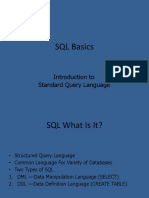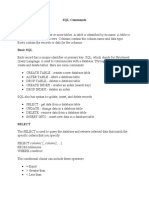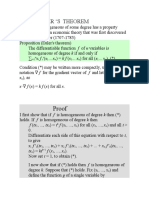0 ratings0% found this document useful (0 votes)
10 viewsSQL More Notes-2
Uploaded by
oluochlawrence31Copyright
© © All Rights Reserved
Available Formats
Download as PPT, PDF, TXT or read online on Scribd
0 ratings0% found this document useful (0 votes)
10 viewsSQL More Notes-2
Uploaded by
oluochlawrence31Copyright
© © All Rights Reserved
Available Formats
Download as PPT, PDF, TXT or read online on Scribd
You are on page 1/ 23
SQL statements: Listing Unique Values
SQL’s DISTINCT clause is used to produce a list
of only those values that are different from
one another.
Syntax:
SELECT DISTINCT <attribute>
FROM <tablename>;
Aggregate functions in SQL
• SQL can perform various mathematical
summaries for you, such as counting the
number of rows that contain a specified
condition, finding the minimum or maximum
values for some specified attribute, summing
the values in a specified column, and
averaging the values in a specified column.
Aggregate functions: COUNT
COUNT - it is used to tally the number of non-null values
of an attribute.
Syntax:
SELECT count <attributes>
FROM <tablename>
WHERE <conditionlist>
When used to count unique non-null values.
Syntax:
SELECT count <DISTINCT attribute>
FROM <tablename>
WHERE <conditionlist>
Aggregate functions: MAX and MIN
MAX and MIN
• The MAX and MIN functions help you find
answers to problems such as the:
– Highest (maximum) price in the PRODUCT table.
– Lowest (minimum) price in the PRODUCT table.
Syntax:
SELECT <MAX(attribute1)>
FROM <tablename>
WHERE <conditionlist>
MAX and MIN cont…
Why is this query wrong?
SELECT *
FROM product
WHERE p_price = MAX(p_price);
Only one parameter is expected to the right of the
equals sign.
Solution:
Compute the maximum price first, then compare it
to each price returned by the query. This is
known as a nested query.
Aggregate functions: SUM and AVG
SUM syntax:
SELECT <SUM(attribute1)> AS <alias>
FROM <tablename>;
AVG syntax:
SELECT <AVG(attribute1)> AS <alias>
FROM <tablename>;
SQL joins
• Supposing you want to retrieve data from two
different tables?
• All you need is an equality comparison of the
foreign key and the primary key of the two
tables.
Inner join
Inner join - returns matched records from the
tables that are being joined.
Syntax:
SELECT <attributes>
FROM <table1, table2>
WHERE table1.attributeX = table2.attributeX
Outer join
• The previous query will exclude any rows which
violates the condition i.e conditions with a null
value at the foreign key. An outer join is used to
include these rows.
• Outer join, the matched pairs would be retained,
and any unmatched values in the other table
would be left null.
• Types of outer joins:
– Left join
– Right join
Outer join cont..
• Left join syntax:
– SELECT <attribute1,table1.attributeX,attribute2>
– FROM <table1> LEFT JOIN <table2>
– ON table1.attributeX = table2.attributeX;
• Right join syntax:
– SELECT <attribute1,table2.attributeX,attribute2>
– FROM <table1> RIGHT JOIN <table2>
– ON table1.attributeX = table2.attributeX;
Outer join cont…
• Left and right refers to the tables in the query.
• In the left outer join the matching fields for
the left table will be included in the results i.e
all displayed fields for the left table will have
data whereas some fields belonging to the
right table will be null.
• In the right outer join all the displayed fields
for the right table will have data whereas
some fields in the left table will be null.
Views
• The output of a relational operator such as
SELECT is another relation(table).
• Suppose it is a routine to get a list of products to
reorder at the end of everyday? It would be
tedious to retype the same query daily.
• Wouldn’t it be better to save the query
permanently to the database?
• A view is a virtual table based on a SELECT query.
• Syntax:
CREATE VIEW <viewname> AS
<SELECT query>
Characteristics of a view
• It can be used anywhere in an SQL query
where a table name is expected.
• Views are dynamically updated - every time a
view is invoked it retrieves accurate and upto
date information.
• Views provide some level of security in a
database – it restricts the users to specified
columns and specified rows in a relation.
Indexes
• An index is an orderly arrangement used to
logically access rows in a table. It is used for
faster searching.
• Syntax:
– CREATE INDEX <indexname> ON
<tablename(columnname)>
Stored procedures
• A stored procedure is a named collection of
procedural and SQL statements that are
stored in a database.
• For example, you can create a stored
procedure to represent a product sale, a
credit update, or the addition of a new
customer. By doing that, you can encapsulate
SQL statements within a single stored
procedure and execute them as a single
transaction.
Stored procedures cont..
• Advantages of stored procedures:
– Stored procedures substantially reduce network
traffic and increase performance. SQL statements
are stored in the server and thus individual
statements are not transmitted over the network
every time they are invoked.
– Stored procedures help reduce code duplication
by means of code isolation and code sharing
Stored procedures cont..
Syntax:
CREATE OR REPLACE PROCEDURE procedure_name
[(argument [IN/OUT] data-type, )]
[IS/AS]
[variable_namedata type[:=initial_value] ]
BEGIN
PL/SQL or SQL statements;
...
END;
Stored procedure syntax cont..
• Argument specifies the parameters that are passed to
the stored procedure. A stored procedure could have
zero or more arguments or parameters.
• IN/OUT indicates whether the parameter is for input,
output, or both.
• Data-type is one of the procedural SQL data types used
in the RDBMS. The data types normally match those
used in the RDBMS table-creation statement.
• Variables can be declared between the keywords IS
and BEGIN. You must specify the variable name, its
data type, and (optionally) an initial value.
Triggers
• A trigger is procedural SQL code that is
automatically invoked by the RDBMS upon the
occurrence of a given data manipulation event.
– A trigger is invoked before or after a data row is
inserted, updated, or deleted.
– A trigger is associated with a database table.
– Each database table may have one or more triggers.
– A trigger is executed as part of the transaction that
triggered it.
Triggers cont…
• Triggers are critical to proper database operation
and management, for example:
– Triggers can be used to enforce constraints that
cannot be enforced at the DBMS design and
implementation levels.
– Triggers add functionality by automating critical
actions and providing appropriate warnings and
suggestions
– For remedial action. Triggers can be used to update
table values, insert records in tables, and call other
stored procedures.
Triggers cont…
• Oracle recommends triggers for:
– Auditing purposes (creating audit logs).
– Automatic generation of derived column values.
– Enforcement of business or security constraints.
– Creation of replica tables for backup purposes.
Triggers cont…
CREATE OR REPLACE TRIGGER trigger_name
[BEFORE / AFTER] [DELETE / INSERT / UPDATE OF
column_name] ON table_name
[FOR EACH ROW]
[DECLARE]
[variable_namedata type[:=initial_value] ]
BEGIN
SQL instruction1;
SQL instruction2;
...
END;
Triggers cont…
A trigger definition contains the following parts:
– The triggering timing: BEFORE or AFTER, this indicates
when the trigger’s PL/SQL code executes; in this case,
before or after the triggering statement is completed.
– The triggering event: the statement that causes the
trigger to execute (INSERT, UPDATE, or DELETE).
– The triggering level: There are two types of triggers:
statement-level triggers and row-level triggers.
– The triggering action: The PL/SQL code enclosed
between the BEGIN and END keywords.
You might also like
- RSI Indicator Trading Strategy, 5 Systems + Back Test Results!100% (9)RSI Indicator Trading Strategy, 5 Systems + Back Test Results!22 pages
- Use Advanced Structured Query Language: Module Title: Nominal DurationNo ratings yetUse Advanced Structured Query Language: Module Title: Nominal Duration19 pages
- SQL Basic Statements 1. The SQL SELECT StatementNo ratings yetSQL Basic Statements 1. The SQL SELECT Statement43 pages
- Best SQL Interview Questions: Q #1) What Is SQL?No ratings yetBest SQL Interview Questions: Q #1) What Is SQL?29 pages
- Interview Questions: Database: 1. Question: What Are The Difference Between Functions and Procedures?No ratings yetInterview Questions: Database: 1. Question: What Are The Difference Between Functions and Procedures?4 pages
- CHAPTER 4. Retrieving Data Using The SQL Select StatementNo ratings yetCHAPTER 4. Retrieving Data Using The SQL Select Statement4 pages
- SQL Basics: Introduction To Standard Query Language100% (2)SQL Basics: Introduction To Standard Query Language34 pages
- (M7S2-POWERPOINT) - Transaction Control CommandsNo ratings yet(M7S2-POWERPOINT) - Transaction Control Commands34 pages
- SQL For Beginners SQL Made Easy For Data AnalysisNo ratings yetSQL For Beginners SQL Made Easy For Data Analysis21 pages
- Unit-6 (Manipulating and Querying Data)No ratings yetUnit-6 (Manipulating and Querying Data)51 pages
- 1ST and 2ND Quarter Prog F2F Final VersionNo ratings yet1ST and 2ND Quarter Prog F2F Final Version56 pages
- Select From Where Select From Where Select From Select From Where Select From Select From Select From Where IS NOT Null Order BY Desc WhereNo ratings yetSelect From Where Select From Where Select From Select From Where Select From Select From Select From Where IS NOT Null Order BY Desc Where23 pages
- What Are The Different Types of Joins? What Is The Difference Between Them? Inner JoinNo ratings yetWhat Are The Different Types of Joins? What Is The Difference Between Them? Inner Join9 pages
- A. 3. 4. A. 5. A. 6. A.: Geek InterviewsNo ratings yetA. 3. 4. A. 5. A. 6. A.: Geek Interviews13 pages
- SQL (Structured Query Language) : Beginner To Intermediate LevelNo ratings yetSQL (Structured Query Language) : Beginner To Intermediate Level21 pages
- Assignment - Law and Justice in A Globalized World - Final-23-39No ratings yetAssignment - Law and Justice in A Globalized World - Final-23-3917 pages
- Keto Chocolate Mousse (3 Ingredients) - The Big Man's World ®No ratings yetKeto Chocolate Mousse (3 Ingredients) - The Big Man's World ®1 page
- LBHM 3Rd All India Open Fide Rated Chess Tournament-2019 Click On Invitation For Prize ListNo ratings yetLBHM 3Rd All India Open Fide Rated Chess Tournament-2019 Click On Invitation For Prize List10 pages
- El402: Embedded System Design CREDITS 5 (L 3, T 0, P 2)No ratings yetEl402: Embedded System Design CREDITS 5 (L 3, T 0, P 2)2 pages
- The Institution of Engineers BangladeshiebNo ratings yetThe Institution of Engineers Bangladeshieb105 pages
- "Ask Me How": Stating Research QuestionNo ratings yet"Ask Me How": Stating Research Question16 pages
- Financial Analysis of Household Photovoltaic Self-Consumption in The Context of The Vehicle-to-Home (V2H) in PortugalNo ratings yetFinancial Analysis of Household Photovoltaic Self-Consumption in The Context of The Vehicle-to-Home (V2H) in Portugal21 pages
- Theory of Stepper Motor 2.1: Drive R Circui T Sequence R Steppe R Moto R Power yNo ratings yetTheory of Stepper Motor 2.1: Drive R Circui T Sequence R Steppe R Moto R Power y14 pages
- Junior Assistant in Telangana State Road Transport CorporationNo ratings yetJunior Assistant in Telangana State Road Transport Corporation23 pages
- Every Letter I Write Is Not A Love Letter': Ina BlomNo ratings yetEvery Letter I Write Is Not A Love Letter': Ina Blom10 pages
- Speakout Perason Intermediate End of Course TestNo ratings yetSpeakout Perason Intermediate End of Course Test8 pages
- RSI Indicator Trading Strategy, 5 Systems + Back Test Results!RSI Indicator Trading Strategy, 5 Systems + Back Test Results!
- Use Advanced Structured Query Language: Module Title: Nominal DurationUse Advanced Structured Query Language: Module Title: Nominal Duration
- Interview Questions: Database: 1. Question: What Are The Difference Between Functions and Procedures?Interview Questions: Database: 1. Question: What Are The Difference Between Functions and Procedures?
- CHAPTER 4. Retrieving Data Using The SQL Select StatementCHAPTER 4. Retrieving Data Using The SQL Select Statement
- SQL Basics: Introduction To Standard Query LanguageSQL Basics: Introduction To Standard Query Language
- Select From Where Select From Where Select From Select From Where Select From Select From Select From Where IS NOT Null Order BY Desc WhereSelect From Where Select From Where Select From Select From Where Select From Select From Select From Where IS NOT Null Order BY Desc Where
- What Are The Different Types of Joins? What Is The Difference Between Them? Inner JoinWhat Are The Different Types of Joins? What Is The Difference Between Them? Inner Join
- SQL (Structured Query Language) : Beginner To Intermediate LevelSQL (Structured Query Language) : Beginner To Intermediate Level
- Assignment - Law and Justice in A Globalized World - Final-23-39Assignment - Law and Justice in A Globalized World - Final-23-39
- Keto Chocolate Mousse (3 Ingredients) - The Big Man's World ®Keto Chocolate Mousse (3 Ingredients) - The Big Man's World ®
- LBHM 3Rd All India Open Fide Rated Chess Tournament-2019 Click On Invitation For Prize ListLBHM 3Rd All India Open Fide Rated Chess Tournament-2019 Click On Invitation For Prize List
- El402: Embedded System Design CREDITS 5 (L 3, T 0, P 2)El402: Embedded System Design CREDITS 5 (L 3, T 0, P 2)
- Financial Analysis of Household Photovoltaic Self-Consumption in The Context of The Vehicle-to-Home (V2H) in PortugalFinancial Analysis of Household Photovoltaic Self-Consumption in The Context of The Vehicle-to-Home (V2H) in Portugal
- Theory of Stepper Motor 2.1: Drive R Circui T Sequence R Steppe R Moto R Power yTheory of Stepper Motor 2.1: Drive R Circui T Sequence R Steppe R Moto R Power y
- Junior Assistant in Telangana State Road Transport CorporationJunior Assistant in Telangana State Road Transport Corporation
- Every Letter I Write Is Not A Love Letter': Ina BlomEvery Letter I Write Is Not A Love Letter': Ina Blom

























































































